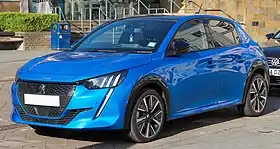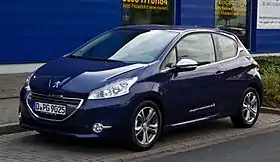Peugeot 208
The Peugeot 208 is a supermini (B-segment in Europe) produced by the French automaker Peugeot, and unveiled at the Geneva Motor Show in March 2012. It is a successor to the Peugeot 207.
| Peugeot 208 | |
|---|---|
 | |
| Overview | |
| Manufacturer | Peugeot (Groupe PSA) |
| Production | 2012–present |
| Body and chassis | |
| Class | Supermini (B) |
| Layout | Front-engine, front-wheel-drive |
| Chronology | |
| Predecessor | Peugeot 207 |
First generation (A9; 2012)
| First generation (A9) | |
|---|---|
 | |
| Overview | |
| Production | March 2012–2019 February 2013–present (Malaysia) |
| Assembly | France: Mulhouse (Mulhouse Plant); Poissy (Poissy Plant) Brazil: Porto Real (PSA Brazil) Malaysia: Gurun (NAM) Slovakia: Trnava (Trnava Plant) Iran: Tehran (IKAP) Algeria: Oran (PSA Algérie) [1] |
| Designer | Pierre Authier[2] |
| Body and chassis | |
| Body style | 3-door hatchback 5-door hatchback |
| Platform | PSA PF1 platform |
| Related | Peugeot 2008 Citroen C3 Citroën C4 Cactus Citroën DS3 |
| Powertrain | |
| Engine | 1.0 L I3 (petrol) 1.2 L I3 (petrol) 1.4 L I4 (petrol) 1.6 L I4 (petrol) 1.4 L I4 (diesel) 1.6 L I4 (diesel) |
| Transmission | 5 and 6-speed manual 4-speed automatic 6-speed automatic |
| Dimensions | |
| Wheelbase | 2,538 mm (99.9 in) |
| Length | 3,962 mm (156.0 in) |
| Width | 1,739 mm (68.5 in) (ex mirrors) |
| Height | 1,460 mm (57.5 in) |
| Curb weight | 975–1,295 kg (2,150–2,855 lb) |
The first 208 models were three door hatchbacks produced in November 2011, at the company's new plant in Slovakia.[3] In June 2012, as five-door hatchbacks became available, production of the 208 also commenced at Peugeot's French plants at Mulhouse, and at Poissy.[4]



The 208, developed under code name "A9",[5] is built on the PSA PF1 platform and the weight is to be reduced by 173 kg (381 lb) (110 kg (243 lb) on average) compared with the 207[6] and still offer more space than the predecessor.
The boot offers 285 L (10 cu ft) (VDA) of space, 15 L (1 cu ft) more than the 207, and the leg room in the rear seat increases 5 cm (2 in). The design was led by Pierre Authier, with Sylvain Henry as exterior designer.
The interior design is by Adam Bazydlo, and the colour and trim is by Marie Sanou. The car features a tablet computer like screen, and panoramic glass roof surrounded by LED lights.[7] The car is relatively aerodynamic with a drag coefficient, Cd, of 0.29.[8]
Engines


All the petrol engines comply with the Euro 5 norm and the diesel engines have CO
2 emissions of 99 g/km or lower. In addition to the four cylinder petrol engines carried over from the previous model, from September 2012, the 208 has been offered with two new three cylinder units with variable valve timing – the 1.0 VTi (68 hp) and 1.2 VTi (82 hp).
The 1.0 comes with an advertised fuel consumption of 4.3 L/100 km (66 mpg‑imp; 55 mpg‑US), and a CO
2 emissions value of 99 g/km. A 1.2 L three cylinder is available with a turbocharger designated as the PureTech 110 S&S (available on the GT Line models and the allures) or without designated PureTech 82 S&S (available on the active, VTi, or XS).
This engine is coupled to a five speed manual or a six speed automatic. The 208 GTi is fitted with a 1.6 litre turbo (1,598 cc) four cylinder in line turbo petrol Prince engine producing 197 bhp (147 kW) at 5,800 rpm and 203 lb⋅ft (275 N⋅m) of torque at 1,700 rpm, and is fitted with a six speed manual transmission.
This first GTi model has since been replaced by the 208 GTi by PeugeotSport which is directly derived from the limited edition '30ème Anniversaire Edition' which put out 208 bhp with revised suspension and an optional two tone paint job, along with a facelift of the original bumpers and other small changes.
The GTi's Prince engine is shared with the Mini and various Citroëns.[9]
The range of diesel units starts with the four-cylinder 1.4-litre e HDi unit, originally introduced in 2010 for the 207, which provides 50 kW (68 PS; 67 hp) of power coupled, in the 208, with published fuel economy and emission figures of 3.4 L/100 km (83 mpg‑imp; 69 mpg‑US) and 87 g/km.[10]
Trims
The 208 comes with a range of trims and specs. Starting from the entry model as of 2019:
- Active – Available with either a 1.2L Puretech 82 S&S Petrol or a 1.5L BlueHDi Diesel, both come with a five speed manual.
- Signature (also known as the allure) – Comes with the same engine and gear box as the active but has different styling and alloys.
- Tech Edition – As well as coming with the same engine as the active and signature it also comes with two additional engine variants. A 1.2 litre Puretech 110 turbocharged manual and a automatic version known as the EAT6, both three cylinders
- GT-Line – This is the top of line model that is available from Peugeot. Coupled with the 1.2L 110 engines both six speed automatic and manual as well as the 1.5 litre diesel. This trim offers all the styling of a hot hatch, it has 16" alloys which are diamond cut.
Second generation (2019)
| Second generation (UB/UJ/UP/UW) | |
|---|---|
 Peugeot e-208 GT | |
| Overview | |
| Production | 2019–present |
| Assembly | Slovakia: Trnava (Trnava Plant) Morocco: Kenitra (Kenitra Plant) Argentina: El Palomar |
| Designer | Yann Beurel[11] |
| Body and chassis | |
| Body style | 5-door hatchback |
| Platform | PSA CMP (EMP1) platform |
| Related | Peugeot 2008 II Opel Corsa F Opel Mokka B |
| Powertrain | |
| Engine | 1.2 L PSA EB2 I3 naturally-aspirated (petrol/flexfuel) 1.2 L PSA EB2 I3 turbo (petrol) 1.6 L PSA EC5 naturally-aspirated (petrol/flexfuel) 1.5 L PSA DW5 BlueHDI I4 (diesel) |
| Electric motor | Permanent Magnet Synchronous Motor (e-208) |
| Transmission |
|
| Battery | 50 kWh |
| Electric range | 340 km (210 mi) |
| Dimensions | |
| Wheelbase | 2,540 mm (100.0 in) |
| Length | 4,055 mm (159.6 in) |
| Width | 1,745 mm (68.7 in) |
| Height | 1,430 mm (56.3 in) |
| Curb weight | 980–1,485 kg (2,160–3,270 lb) |



The second generation Peugeot 208 was unveiled at the Geneva Motor Show in March 2019, and officially went on sale across Europe over the summer.[12] A fully electric version, named e208, was also revealed at Geneva. The 208 offers a choice of powertrains, using conventional petrol or diesel engines, or an electric motor.
Technical
The drivetrains and platform of the 208 are shared with the Peugeot 2008, the Citroën DS 3 Crossback and Opel Corsa.[13][12] The conventional petrol engines branded "PureTech" are all 1.2-litre, three-cylinder naturally aspirated EB2 either petrol-only or ethanol-capable flex fuel with 74bhp or turbo EB2 with 99 and 128bhp, except the versions made in Argentina which use the 1.6-litre naturally-aspirated EC5 either petrol-only or ethanol-capable flex fuel for export to Brazil.
The diesel model will come in just one engine variant, a 1.5-litre four cylinder engine producing 99bhp. Peugeot have yet to announce the sport models and what engine they will be using, such as the GTi which has been part of the family of the 208.[12]
However, Guillaume Clerc, the project manager for the second generation 208, stated that development of a petrol 208 GTi ended in 2017, because it was impossible to meet the corporate average CO
2 emission targets with the larger 1.6-litre engine used in the previous generation 208 GTi. Clerc hinted the next GTi could be based on the e208.[14]
The 208 and e208 are available with optional advanced driver-assistance systems, featuring adaptive cruise control, lane centering, automatic parking, and blind spot monitoring. Models equipped with a manual transmission feature cruise control down to a minimum speed of 18 mph (29 km/h); the automatic and e208 models can control the car down to a stop.[12]
e208 (electric version)
Unlike competing contemporary vehicles such as the Renault Zoe and Volkswagen ID.3, the e208 shares a common chassis with the conventional petrol/diesel powered 208. Peugeot chose this deliberately to enable potential buyers to select the drivetrain that best suits their requirements.[15]
This also allows Peugeot to assemble the e208 on the same line as the other versions.[16] Compared to the conventionally powered versions of the 208, the e208 is approximately 350 kg (770 lb) heavier,[12] and has a slightly wider rear axle, to accommodate the battery pack.[16]
The e208 has a heat-pump controlled 50 kWh battery, a 100 kW (130 hp) motor, and a 6.6 kW charger. WLTP range is 340 km (211 mi).[17][18] It is equipped with a CCS Combo Type 2 connector, and can charge at a rate of up to 100 kW from a suitable DC fast charging station.
Charge rate can be 70kW up to 40% state of charge, then decreasing to 50kW.[19] The onboard charger is limited to 7.4 kW, but may be equipped with a three phase 11 kW charger as an option.[20] In the e208, the gear selector is used to choose the level of regenerative braking.[16]
Shortly after it went on sale in October 2019, demand for the e208 was strong. Peugeot had anticipated making approximately 30,000 e208 cars per year, 10% of the planned annual production of 300,000 for the entire 208 product line, but 1⁄4 of all preorders received were for the e208. Maximum production for the e208 is 60,000 per year.[21]
| Petrol engines[22] | |||||||
|---|---|---|---|---|---|---|---|
| Model | Type | Power, Torque@rpm | 0–100 km/h (0-62 mph) (s) | Top speed | Transmission | CO 2 emission (g/km) |
Years |
| 1.2 PureTech 75 S&S | 1,199 cc (73.2 cu in) I3 | 74 hp (55 kW; 75 PS) @ 5750, 118 N⋅m (87 lb⋅ft) @ 2750 | 13.2 | 102 mph (164 km/h) | 5 speed manual | 93–98 | 2019– |
| 1.2 PureTech 100 S&S | 1,199 cc (73.2 cu in) I3 | 100 hp (75 kW; 101 PS) @ 5500, 205 N⋅m (151 lb⋅ft) @ 1750 | 9.9 | 117 mph (188 km/h) | 6 speed manual | 96–102 | 2019– |
| 1.2 PureTech 100 EAT8 S&S | 1,199 cc (73.2 cu in) I3 | 100 hp (75 kW; 101 PS) @ 5500, 205 N⋅m (151 lb⋅ft) @ 1750 | 10.8 | 117 mph (188 km/h) | 8 speed automatic | 97–104 | 2019– |
| 1.2 PureTech 130 EAT8 S&S | 1,199 cc (73.2 cu in) I3 | 129 hp (96 kW; 131 PS) @ 5500, 230 N⋅m (170 lb⋅ft) @ 1750 | 8.7 | 129 mph (208 km/h) | 8 speed automatic | 101–108 | 2019– |
| Diesel engine[22] | |||||||
| 1.5 BlueHDi 100 | 1,499 cc (91.5 cu in) I4 | 100 hp (75 kW; 101 PS) @ 3500, 250 N⋅m (184 lb⋅ft) @ 1750 | 10.2 | 117 mph (188 km/h) | 6 speed manual | 84–92 | 2019– |
| Electric motor (e-208)[22] | |||||||
| Battery capacity | Power, Torque | 0–100 km/h (s) | Top speed | Transmission | Range (WLTP) | Years | |
| 50 kWh Lithium Ion Battery | 136 hp (101 kW; 138 PS), 260–300 N⋅m (192–221 lb⋅ft) |
8.1 | 93 mph (150 km/h) | 1 speed automatic | 217 mi (349 km) | 2019– | |
Sales and production
Peugeot announced the 300,000th 208 was produced in February 2013.[23]
| Year | Worldwide production | Worldwide sales | Notes |
|---|---|---|---|
| 2011 | TBA | 631[24] | |
| 2012 | 242,900[25] | 220,800[25] | Total production reaches 243,600 units.[25] |
| 2013 | 333,800[26] | 334,439[26] | Total production reaches 577,400 units.[26] |
Motorsport
208 T16 Pikes Peak

In April 2013, a 208 T16 was tested by Sébastien Loeb at Mont Ventoux.[27] Loosely based on the shape and design of the production 208, the T16 is a lightweight 875 kg (1,929 lb) vehicle that uses the rear wing from the Peugeot 908, and has a 3.2 litre, twin turbo V6 engine, developing 875 bhp (652 kW; 887 PS) and 0–100 km/h in just 1.8s[28] with the aim of competing at the Pikes Peak International Hill Climb.
At Pikes Peak on 30 June 2013, Sébastien Loeb used the 208 T16 to break Rhys Millen's record time, set in 2012[29] on the first fully paved roads in the history of the competition.[30] The previous record of 9:46.164[31] was shattered, and a new record time of 8:13.878 was set.[32]
The car also won the hillclimbing race, at the 2014 Goodwood Festival of Speed in June 2014.
Racing
In 2018, a Peugeot 208 GTi 30th Edition model won the overall award in the inaugural Classic Sports Car Club Turbo Tin Tops Series, for forced induction front wheel drive cars. [33]
Rallycross
Team Peugeot-Hansen won the manufacturers title at the FIA World Rallycross Championship in November 2015. Jérôme Grosset-Janin was runner up in the FIA European Rallycross Championship in the same year.
References
- "Peugeot Algérie : Ouverture des pré-commandes sur la 208 Tech Vision made in Algérie". Autobip (in French).
- Peugeot 208 GTi
- "Professional MBA Automotive Industry: Factory visit and workshop at PSA Peugeot Citroën in Trnava". tuwien.ac.at.
- "Avec la 208 PSA Mulhouse voit la vie en rose". La Tribune.
- "Peugeot 208 Arrives in Europe Next Spring". Inside Line. 4 November 2011. Retrieved 26 July 2012.
- Dinside.no Norwegian
- "New Peugeot 208 on sale next summer" by motoring.co.uk. Visited 2011-11-22
- 2012 Peugeot 208 Design Details Archived 2012-01-25 at the Wayback Machine by newcarspec.com 2011-11-16 visited 2011-11-22.
- English, Andrew (4 April 2013). "Peugeot 208 GTi review". The Daily Telegraph. London. Retrieved 26 August 2013.
- tv2.no Norwegian
- "Les designers Peugeot racontent la nouvelle 208". Lignes Auto (in French).
- "New 2020 Peugeot 208 prices confirmed, electric e-208 tops £25,050". Car. 8 August 2019. Retrieved 8 April 2020.
- Mahoney, John (September 14, 2018). "DS 3 Crossback makes global debut". Motoring. Retrieved 8 April 2020.
- Kew, Ollie (2 October 2019). "So what's going on with the new Peugeot 208 GTI?". Top Gear. BBC. Retrieved 11 April 2020.
- Lane, Richard (2 October 2019). "Peugeot e-208 GT 2019". Autocar. Retrieved 7 April 2020.
- Prior, Matt (12 July 2019). "Peugeot 208 1.2 Puretech GT Line 2020 review". Autocar. Retrieved 7 April 2020.
- Dalløkken, Per Erlien (4 July 2019). "Nye Peugeot e-208: 50 kWh batteri for under 250.000 kroner". Tu.no (in Norwegian). Teknisk Ukeblad.
- "PEUGEOT e-208 official specs". PushEVs. 25 February 2019.
- Valle, Marius (30 April 2020). "Det er lett å like Peugeots nye elbil". Tu.no (in Norwegian). Teknisk Ukeblad.
- "Charging your electric Peugeot". Peugeot UK. Retrieved 7 April 2020.
- Ciferri, Luca (October 4, 2019). "Peugeot sees stronger-than-expect demand for electric 208, CEO says". Automotive News Europe. Retrieved 11 April 2020.
- All-New Peugeot 208 UK Brochure (PDF). August 2019. pp. 19–20. Retrieved 9 February 2020.
- "Peugeot produces its 300 000th 208". Peugeot. 26 February 2013. Retrieved 14 June 2013.
- "PSA Annual Report 2012" (PDF). Car manufacturers. PSA. Retrieved 4 April 2013.
- "Memento Mars 2013" (in French). PSA Peugeot Citroën. 21 February 2013: 50. Retrieved 31 July 2013. Cite journal requires
|journal=(help) - "Memento Mars 2014" (in French). PSA Peugeot Citroën. March 2014: 54, 63. Retrieved 2014-09-26. Cite journal requires
|journal=(help) - "Peugeot reveals full spec of Loeb's 875bhp, 875kg Pikes Peak T16". Autosport. 23 April 2013.
- Fagnan, René (23 April 2013). "Rally: Technical specifications of the Peugeot 208 T16 Pikes Peak | Auto123.com". Retrieved 27 February 2020.
0-100 km/h: 1.8s
- "Sébastien Loeb breaks Rhys Millen's time at Pikes Peak". Pikes Peak International Hill CLimb. PPIHC. Archived from the original on 23 July 2013. Retrieved 11 July 2013.
- "Sébastien Loeb breaks record". Retrieved 16 July 2013.
- Jonathon Ramsey. "Sebastien Loeb demolishes Pikes Peak record with an 8:13.878 [UPDATE: w/video]". Autoblog.
- "875bhp twin-turbo Peugeot 208 T16". Autocar. Retrieved 14 June 2013.
- https://www.classicsportscarclub.co.uk/turbo-tin-tops
External links
| Wikimedia Commons has media related to Peugeot 208 A. |
| Awards | ||
|---|---|---|
| Preceded by Citroën DS3 WRC |
Autosport Awards Rally Car of the Year 2013 |
Succeeded by Volkswagen Polo R WRC |

